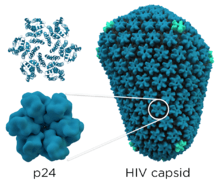P24 capsid protein
p24 is a component of the HIV particle capsid. There are approximately 2000 molecules per virus particle, or at a molecule weight of 24 kDa, about 104 virus particles per picogram of p24. The onset of symptoms of AIDS correlates with a reduction in the number of CD4+ T-cells and increased levels of virus and p24 in the blood.[1] It is a component of the gag polyprotein.

Fourth generation HIV test
Fourth-generation HIV immunoassays detect viral p24 protein in the blood (as well as patient antibodies against the virus). Previous generation tests relied on detecting patient antibodies alone; it takes about 3–4 weeks for the earliest antibodies to be detected. The p24 protein can be detected in patient blood as early as 2 weeks after HIV infection, further reducing the window period necessary to accurately detect the HIV status of the patient.[2]
References
- http://tronolab.epfl.ch/webdav/site/tronolab/shared/protocols/TUvsp24.html
- http://capitolregiontelehealth.org/documents/AETC-Webinar-2.pdf
- Medical Microbiology, p637
- http://hivinsite.ucsf.edu/InSite.jsp?page=kb-02-02-01